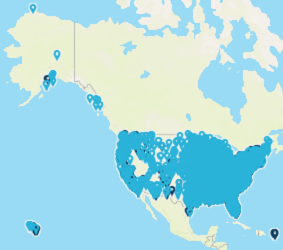Lung cancer screening
"That billboard saved my life"
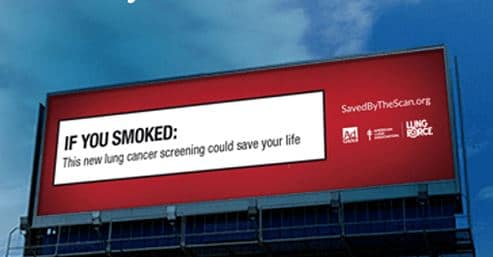
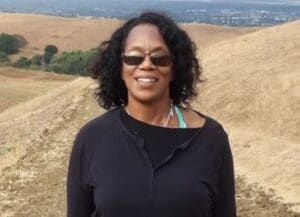
“When I first saw the ‘Saved By The Scan’ billboard, I didn’t know what a low-dose CT scan was,” says Denise. “I was a former smoker and didn’t know that early detection was available. I thought that the only way to find lung cancer was through a chest X-ray.”
Her doctor didn’t initially order the test for her, so Denise persisted. The scan led to a biopsy “and the next day I learned that I had a malignant tumor that was stage IB.”
Denise had surgery and chemotherapy and later joined a clinical trial. “The clinical trial examined the role of immunotherapy in helping to prevent recurrence for those like me who had been tested for the PDL-1 protein.”
“I always encourage others who may be eligible for lung cancer screening to speak with their physician about screening. I often say- one of the things that prompted me to get screened was that I knew that lung cancer is often not detected until it has spread. Early detection is key—regardless of the cancer.”
Source: “Denise’s ‘Saved By The Scan’ Story” on the American Lung Association website
"I sing because I am saved by the scan"
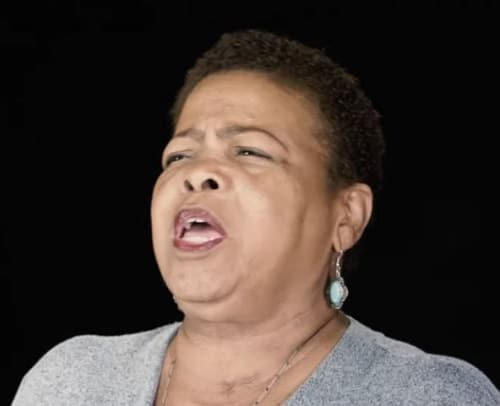
“Look, I was a 45-year long smoker,” says Milli. “I never thought I’d get lung cancer. My mother had passed 20 years ago from lung cancer. My brother 19 years. They were both diagnosed at stage four, but I never thought I’d get it. You never think it will be me.”
“One day I was watching television and saw a public service commercial that advertised early detection and I listened really closely and found out that I might meet the criteria. So I got in touch with my doctor.”
“I got the results back. Not only did I have lung cancer, but it was a huge 6 centimeter mass in my upper right lobe. I was so scared I wouldn’t be able to sing again. I was so scared that it had spread somewhere else.”
“I had the right upper lobe removed. They took out 17 lymph nodes, all negative. The margins around the cancer were negative. So, I ended up having stage one lung cancer. I no longer smoke. My family, we’ve all quit smoking.”
“I’m a very emotional person, but this emotion is joy because I’ve been given another chance. I sing because I’m happy. I sing because I am ‘Saved by the Scan’.”
Source: How “Saved By The Scan” Saved Milli’s Life, a 3-minute video from the American Lung Association
Quick scan can find treatable lung cancers
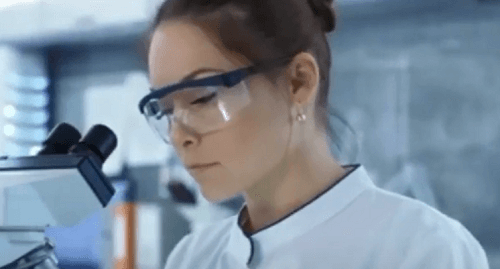
Almost 80 percent of lung cancers are detected where they’ve already spread to other parts of the body. So, at that point, surgery is not an option. If you do an annual low-dose chest CT, you’ll find nodules or small cancers early where they can be treated for a cure.
A 2-minute video from the University of Virgina.
Waiting for symptoms may be too late
You quit smoking and thought that’s that. But here’s the thing about lung cancer: by the time you see the symptoms, it could be too late. But now, there’s a new scan that can detect lung cancer early when it’s more cureable.
A 30-second video from the American Lung Association.
New lung scan takes only 10 minutes
What lung cancer screening is like: It’s fast and painless. Watch this video to learn what to expect during a screening.
A 5-minute video from the Go2 Foundation for Lung Cancer.
Screening recommendations
U.S. Preventive Services Task Force (2021)
The USPSTF recommends annual screening for lung cancer with low-dose computed tomography (LDCT) in adults aged 50 to 80 years who have a 20 pack-year smoking history and currently smoke or have quit within the past 15 years. Screening should be discontinued once a person has not smoked for 15 years or develops a health problem that substantially limits life expectancy or the ability or willingness to have curative lung surgery.
This recommendation replaces the 2013 USPSTF recommendation on screening for lung cancer. In 2013 the USPSTF recommended annual screening for lung cancer with LDCT in adults aged 55 to 80 years who have a 30 pack-year smoking history and currently smoke or have quit within the past 15 years.
Source: U.S. Preventive Services Task Force. Lung Cancer: Screening (2021)
The U.S. Preventive Services Task Force is an independent, volunteer panel of national experts in disease prevention and evidence-based medicine who make evidence-based recommendations about clinical preventive services. Most private insurance plans are required to cover without a copay recommended preventive services that receive a grade of A or B from the Task Force.
The U.S. Preventive Services Task Force changed its lung cancer screening guidelines in 2021 because the previous guidelines left out too many African American smokers who were at risk of lung cancer.
The previous guidelines were based on White smoking habits and recommended CT screening for smokers age 55 to 80 with a 30 pack-year history who still smoke – or quit only within the past 15 years. African American smokers, however, tend to smoke fewer cigarettes overall compared to white smokers, but their lung cancer risk remains high.
In a study of 48,364 people who were or had been smokers, 84 percent of White smokers with lung cancer met the 30-pack-year bar, but only about half of Black smokers with lung cancer did. The Task Force has now lowered the pack-year requirement from 30 to 20 and lowered the minimum age from 55 to 50.
See “Updated Guidelines for Lung Cancer Screening Aim to Reduce Disparities” on the Vanderbilt University Medical Center website (May 5, 2021)
American Lung Association (2021)
If you meet the following criteria, you are considered to be at “high risk” for developing lung cancer and screening is recommended:
- 50-80 years of age
- Have a 20 pack-year history of smoking (this means 1 pack a day for 20 years, 2 packs a day for 10 years, etc.)
- AND, are a current smoker, or have quit within the last 15 years
At this time, there is not enough evidence to show that screening is recommended for other groups.
Source: American Lung Association: Questions and Answers About Lung Cancer (2021)
American Cancer Society (2013)
The American Cancer Society recommends annual lung cancer screening with a low-dose CT scan (LDCT) for certain people at higher risk for lung cancer who meet the following conditions:
- Are aged 55 to 74 years and in fairly good health, and
- Currently smoke or have quit within the past 15 years, and
- Have at least a 30-pack-year smoking history, and
- Receive smoking cessation counseling if they are current smokers, and
- Have been involved in informed/shared decision making about the benefits, limitations, and harms of screening with LDCT scans, and
- Have access to a high-volume, high quality lung cancer screening and treatment center.
Source: American Cancer Society Lung Cancer Screening Guideline (2013)
Lung Cancer Risk Calculator
Do you want to know if you should be screened? Use this calculator developed by the University of Michigan to see your personalized lung cancer risk.
Lung Cancer Screening Locator Tool
You should only be screened at an accredited facility. Use this locator tool developed by the American College of Radiology to find a facility in the U.S.
Insurance Coverage of Lung Cancer Scanning
US Preventive Services Task Force recommendations for lung cancer screening were updated in early 2021. Insurance companies are required to provide certain recommended screenings free of charge, but these changes may not be reflected yet in company insurance coverage.
Contact your insurance provider to confirm whether lung cancer screening would be covered for you if you are: i) between 50 and 54 years old with a smoking history of more than 20 pack-years; or ii) between 55 and 80 years old with a smoking history of 20-29 pack-years.
Details from the University of Michign about current coverage by employer-sponsored plans, state insurance marketplace plans, Medicare, Medicaid, and individual plans
How Lung Cancer is Diagnosed After Scanning
“When you find out you have a spot on the lung, it is very scary,” says Elisabeth Dexter, MD, thoracic surgeon at Roswell Park Comprehensive Cancer Center in Buffalo, New York.
“It doesn’t always mean that it’s going to a cancer. So we would like to do the correct testing in the correct order to make sure that we have the right diagnosis and then specify, if it happens to be a cancer, what cell types and whether it has spread or not so we can recommend the right treatment.”
A 3-minute video from Roswell Park Comprehensive Cancer Center.


